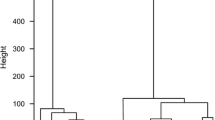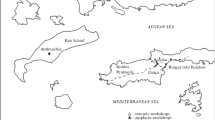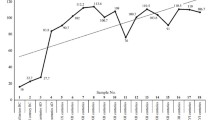Abstract
Thirty samples of the unglazed ceramics selected from a range of medieval sites within the Shu-Talas interfluve, Southern Kazakhstan, were used in the methodical study aimed to reveal “a chemical fingerprint” enabling preliminary differentiation of the restricted quantity of wares. Ratios of the rare earth element (REE) contents in the samples including light to heavy REE fractionation and the values of Eu and Ce anomalies were found the most promising to solve the task. To verify the assumptions binary scatterplots, factor and cluster analysis were applied to the contents of some major, minor and trace elements determined by X-ray fluorescence and neutron activation analysis. The first results were obtained relating the places of pottery burial to the production sites accounting for ware transfer for sale or other.






Similar content being viewed by others
Notes
In Turkic languages it means tetragons or buildings orientated on the four corners of the earth.
References
Klesner CE, Brandi ML, Dussubieux L et al (2019) Local production and long-distance trade of Islamic glazed ceramics in Central Asia: a compositional analyses of ceramics from Southern Kazakhstan by NAA and LA-ICP-MS. J Archaeol Sci Rep. https://doi.org/10.1016/j.jasrep.2019.101905
Klesner CE, Renson V, Akymbek Y et al (2021) Investigation of provenances of Early Islamic lead glazes from northern Central Asia using elemental and lead isotope analyses. Archaeol Anthropol Sci. https://doi.org/10.1007/s12520-021-01444-8
Klesner CE, Akymbek Y, Vandiver PB (2021) Lead-glazing technology from Medieval Central Asia: a case study from Aktobe Kazakhstan. J Archaeol Sci Rep. https://doi.org/10.1016/j.jasrep.2021.102825
Dias MI, Prudêncio MI, Valera AC (2017) Provenance and circulation of Bell Beakers from Western European societies of the 3rd millennium BC: the contribution of clays and pottery analyses. Appl Clay Sci 146:334–342
Mommsen H (2011) Provenancing of pottery. Nuclear techniques for cultural heritage research. IAEA, Vienna
Glascock MD, Neff H (2003) Neutron activation analysis and provenance research in archaeology. Meas Sci Technol 14:1516–1526
Braekmans D, Degryse P, Poblome J et al (2011) Understanding ceramic variability: an archaeometrical interpretation of the Classical and Hellenistic ceramics at Düzen Tepe and Sagalassos (Southwest Turkey). J Archaeol Sci 38:2101–2115
Guirao D, Pla F, Acosta A (2014) The archaeometric characterization of majolica ceramics from Talavera de la Reina and El Puente del Arzobispo (Toledo, Spain). Archaeometry 56:746–763
Bakraji EH, Abboud R, Issa H (2014) Provenance study of archaeological ceramics from Syria using XRF multivariate statistical analysis and thermoluminescence dating. J Ceram. https://doi.org/10.1155/2014/681017
Tripati S, Parthiban G, Pattan JN et al (2017) Chemical composition and provenance of Chinese porcelain shards recovered from Old Goa, west coast of India. J Archaeol Sci Rep. https://doi.org/10.1016/j.jasrep.2017.06.002
Glascock MD, Neff H, Vaughn KJ (2004) Instrumental neutron activation analysis and multivariate statistics for pottery provenance. Hyperfine Interact 154:95–105
Alden JR, Minc L, Lynch TF (2006) Identifying the sources of Inka period ceramics from northern Chile: results of a neutron activation study. J Archaeol Sci 33:575–594
Baria R, Cano NF, Silva-Carrera BN et al (2015) Archaeometric studies of ceramics from the São Paulo II archaeological site. J Radioanal Nucl Chem 306:721–727
Santos JO, Munita CS, Valério MEG et al (2008) Correlations between chemical composition and provenance of Justino site ceramics by INAA. J Radioanal Nucl Chem 278:185–190
Santos JO, Reis MS, Munita CS et al (2017) Box-Cox transformation on dataset from compositional studies of archaeological potteries. J Radioanal Nucl Chem 311:1427–1433
Nunes KP, Toyota RG, Oliveira PMS et al (2013) Preliminary compositional evidence of provenance of ceramics from Hatahara archaeological site Central Amazonia. J Chem. https://doi.org/10.1155/2013/701748
Pino F, Sajo-Castelli AM, Barros H et al (2013) K0-INAA of Venezuelan ceramics and complete statistical analysis to establish their provenance. J Radioanal Nucl Chem 298:1257–1272
Munita CS, Barroso LP, Oliveira PMS (2013) Variable selection study using Procrustes analysis. Open J Archaeom. https://doi.org/10.4081/arc.2013.e7
Bishop RL, Canouts V, Crown PL, Atley SP (1990) Sensitivity, precision, and accuracy: their roles in ceramic compositional data bases. Am Antiq 55:537–546
Carvalho PR, Munita CS, Neves EG et al (2020) A preliminary assessment of the provenance of ancient pottery through instrumental neutron activation analysis at the Monte Castelo site, Rondônia, Brazil. J Radioanal Nucl Chem 324:1053–1058
Kuleff I, Djingova R (1996) Provenance study of pottery; choice of elements to be determined. ArchéoSciences, revue d’Archéométrie 2:57–67
Kasztovszky Z, Szilágyi V, Biró KT et al (2017) Ceramics, marbles and stones in the light of neutrons: Characterization by various neutron methods. In: Kardjilov N, Festa G (eds) Neutron methods for archaeology and cultural heritage. Springer, Cham
Kasztovszky Z, Révay Z, Belgya T et al (2011) Archaeometry applications of cold neutron based prompt gamma neutron activation analysis. Nuclear techniques for cultural heritage research. IAEA, Vienna
Monroy-Guzman F, Fournier P (2003) Elemental composition of Mexican colonial majolica using INAA. Nuclear analytical techniques in archaeological investigations. IAEA, Vienna
Finlay AJ, McComish JM, Ottley CJ et al (2012) Trace element fingerprinting of ceramic building material from Carpow and York Roman fortresses manufactured by the VI Legion. J Archaeol Sci 39:2385–2391
Prudêncio MI, Dias MI, Trindade MJ et al (2012) Rare earth elements as tracers for provenancing ancient ceramics. Estudos do Quaternário 8:6–12
Prudêncio MI (2008) Ceramic in ancient societies: a role of nuclear methods of analysis. In: Koskinen AN (ed) Nuclear chemistry: New research. Nova Science Publishers, New York
Tite MS (2008) Ceramic production, provenance and use—a review. Archaeometry 50:216–231
Mao L, Du J, Mo D, et al (2015) Rare earth elements geochemistry of ceramics excavated from Tongguanyao site, China. In: Proceedings of the International conference on advances in energy, environment and chemical engineering (AEECE-2015), pp 810–813
Belfiore CM, La Russa MF, Barca D (2014) A trace element study for the provenance attribution of ceramic artefacts: the case of Dressel 1 amphorae from a late-Republican ship. J Archaeol Sci 43:91–104
Diskin S, Ashle C (2016) Characterisation of archaeological ceramics from the Khwebe Hills of northern Botswana. J Archaeol Sci Rep 6:574–583
Akymbek Y, Shagyrbayev M, Nurgali N (2022) Ceramics of the medieval tortkul site of Talapty (According to excavations in 2021). In: Proceedings of the V International Congress of Archaeology of the Eurasian Steppes. vol 5, pp 157–168 (in Kazakh)
Akymbek Y, Shagyrbayev M (2022) Analysis of the archaeozoological material of the medieval tortkul Talapty (According to the excavations of 2021). Kazakhstan Archeol 2(16):136–154 (in Kazakh)
Akymbek Y, Shagyrbayev M, Nurgali N (2022) Medieval tortkul of Arna (Based on 2021 research results). In: Proceedings of International Scientific and Methodical Conference “XIV Orazbayev Readings”, pp 22–44 (in Kazakh)
Speakman RJ, Little NC, Creel D et al (2011) Sourcing ceramics with portable XRF spectrometers? A comparison with INAA using Mimbres pottery from the American Southwest. J Archaeol Sci 38:3483–3496
Silachyov I (2016) Rare earths analysis of rock samples by instrumental neutron activation analysis, internal standard method. J Radioanal Nucl Chem 310:573–582
Silachyov IYu (2017) Neutron activation analysis of geological samples for rare metals using Fe as an internal standard. News Acad Sci RK, Ser Chem & Technol 421(1):82–90 (in Russian)
Silachyov IYu (2020) Instrumental neutron activation analysis of rhenium in uranium raw material. Int J Biol Chem 13(1):161–169
Silachyov IYu (2021) Determination of indium in its ore resources by comparator neutron activation analysis. Int J Biol Chem 14(2):106–116
Silachyov I (2023) Zircon concentrate analysis for sixteen rare earth elements by the complex of nuclear analytical methods. J Radioanal Nucl Chem 332:2017–2026
ISO 13528:2022 (2022) Statistical methods for use in proficiency testing by Interlaboratory comparisons. Genève, Switzerland
Saiano F, Pantani OL, Scalenghe R (2019) A rapid method of screening ceramic artefacts to reject unlikely hypotheses of provenance. Geoarchaeology 34(6):759–767
Liu H, Guo H, Pourret O et al (2021) Distribution of rare earth elements in sediments of the North China Plain: a probe of sedimentation process. Appl Geochem. https://doi.org/10.1016/j.apgeochem.2021.105089
de Freitas TO, Pedreira RM, Hatje V (2021) Distribution and fractionation of rare earth elements in sediments and mangrove soil profiles across an estuarine gradient. Chemosphere. https://doi.org/10.1016/j.chemosphere.2020.128431
Zhukova IA, Stepanov AS, Jiang SY et al (2021) Complex REE systematics of carbonatites and weathering products from uniquely rich Mount Weld REE deposit Western Australia. Ore Geol Rev. https://doi.org/10.1016/j.oregeorev.2021.104539
Vodyanitskii YuN (2012) Geochemical fractionation of lanthanides in soils and rocks: a review of publications. Eurasian Soil Sci 45:56–67
Tang M, Rudnick RL, McDonough WF et al (2015) Europium anomalies constrain the mass of recycled lower continental crust. Geology 43(8):703–706
Prudêncio MI, Dias MI (2008) On the importance of using scandium to normalize geochemical data preceding multivariate analyses applied to archaeometric pottery studies. Microchem J 88(2):136–141
Hein A, Kilikoglou V (2020) Ceramic raw materials: how to recognize them and locate the supply basins: chemistry. Archaeol Anthropol Sci. https://doi.org/10.1007/s12520-020-01129-8
Acknowledgements
This work was supported by the grants № BR09158958 from Ministry of Energy of the Republic of Kazakhstan and № AP09260358 from Ministry of Science and Higher Education of the Republic of Kazakhstan.
Funding
Ministry of Energy of the Republic of Kazakhstan, № BR09158958, Igor Silachyov, Ministry of Scientific and Technological Development, Higher Education and Information Society, № AP09260358,Yeraly Akymbek.
Author information
Authors and Affiliations
Corresponding author
Ethics declarations
Conflict of interest
The authors have no competing interests to declare that are relevant to the content of this article.
Additional information
Publisher's Note
Springer Nature remains neutral with regard to jurisdictional claims in published maps and institutional affiliations.
Rights and permissions
Springer Nature or its licensor (e.g. a society or other partner) holds exclusive rights to this article under a publishing agreement with the author(s) or other rightsholder(s); author self-archiving of the accepted manuscript version of this article is solely governed by the terms of such publishing agreement and applicable law.
About this article
Cite this article
Silachyov, I., Akymbek, Y. Element content of the samples of medieval ceramics from Southern Kazakhstan: searching the way of preliminary differentiation. J Radioanal Nucl Chem 332, 3799–3811 (2023). https://doi.org/10.1007/s10967-023-09073-2
Received:
Accepted:
Published:
Issue Date:
DOI: https://doi.org/10.1007/s10967-023-09073-2




